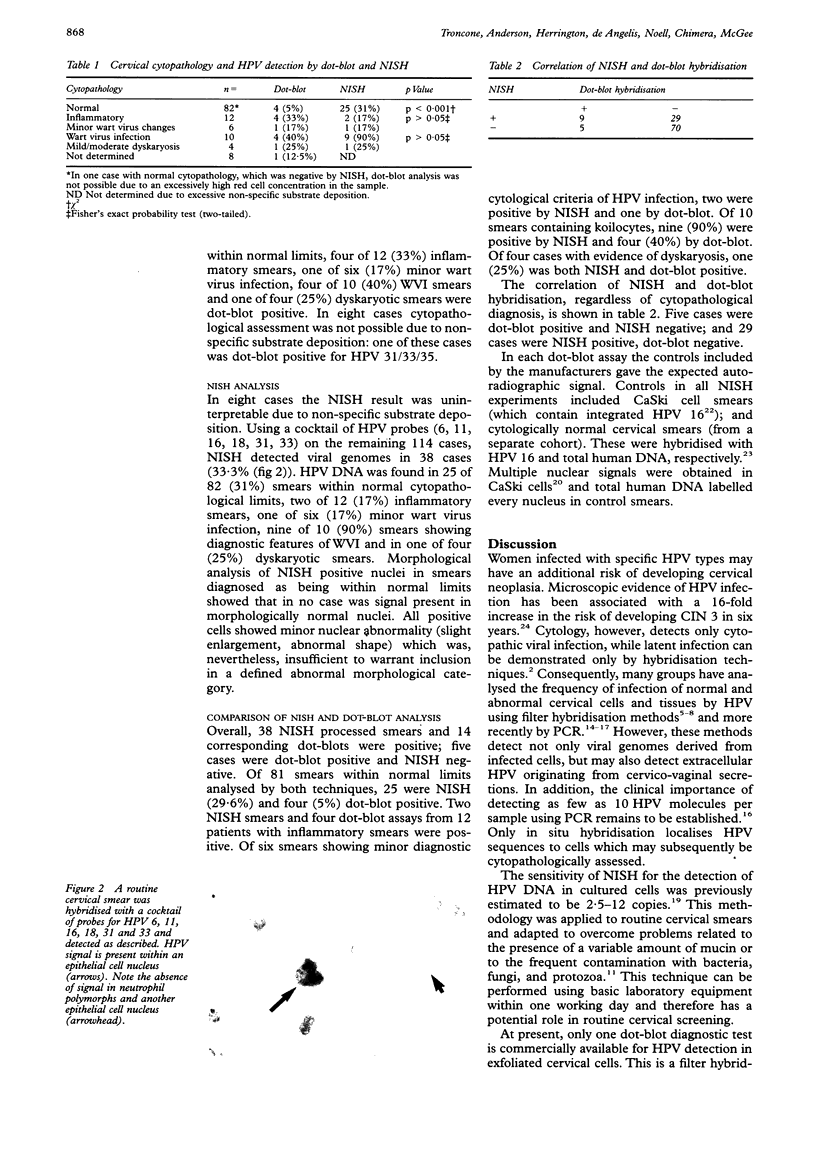Abstract
AIMS: To determine the relative diagnostic performance of non-isotopic in situ hybridisation (NISH) and a dot-blot assay for detecting human papillomavirus (HPV) on exfoliated cervical cells; and to correlate the results with cytopathological assessment. METHODS: Cervical smears and cytological samples were obtained from 122 patients during the same clinical examination and the presence of HPV sequences determined by NISH and dot-blot analysis, respectively. RESULTS: Dot-blot analysis gave an autoradiographic signal in 15 of 121 (12.4%) cases, while NISH detected viral genomes in 38 of 114 (33.3%) cases. Even in the presence of koilocytosis, where vegetative replication of the virus occurs, NISH was positive in over twice as many cases as dot-blot analysis (NISH 90%, dot-blot 40%), while in smears within normal cytological limits, where the viral copy number is likely to be considerably lower, the differences were more striking (NISH 31%, dot-blot 5%). CONCLUSIONS: These data show that NISH on cytological smears is more sensitive than a standardised dot-blot hybridisation assay for detecting HPV infection in cytological material and is therefore a more appropriate screening tool.
Full text
PDF




Images in this article
Selected References
These references are in PubMed. This may not be the complete list of references from this article.
- Bauer H. M., Ting Y., Greer C. E., Chambers J. C., Tashiro C. J., Chimera J., Reingold A., Manos M. M. Genital human papillomavirus infection in female university students as determined by a PCR-based method. JAMA. 1991 Jan 23;265(4):472–477. [PubMed] [Google Scholar]
- Burns J., Graham A. K., McGee J. O. Non-isotopic detection of in situ nucleic acid in cervix: an updated protocol. J Clin Pathol. 1988 Aug;41(8):897–899. doi: 10.1136/jcp.41.8.897. [DOI] [PMC free article] [PubMed] [Google Scholar]
- Burns J., Redfern D. R., Esiri M. M., McGee J. O. Human and viral gene detection in routine paraffin embedded tissue by in situ hybridisation with biotinylated probes: viral localisation in herpes encephalitis. J Clin Pathol. 1986 Oct;39(10):1066–1073. doi: 10.1136/jcp.39.10.1066. [DOI] [PMC free article] [PubMed] [Google Scholar]
- Cooper K., Herrington C. S., Graham A. K., Evans M. F., McGee J. O. In situ human papillomavirus (HPV) genotyping of cervical intraepithelial neoplasia in South African and British patients: evidence for putative HPV integration in vivo. J Clin Pathol. 1991 May;44(5):400–405. doi: 10.1136/jcp.44.5.400. [DOI] [PMC free article] [PubMed] [Google Scholar]
- Herrington C. S., Burns J., Graham A. K., Evans M., McGee J. O. Interphase cytogenetics using biotin and digoxigenin labelled probes I: relative sensitivity of both reporter molecules for detection of HPV16 in CaSki cells. J Clin Pathol. 1989 Jun;42(6):592–600. doi: 10.1136/jcp.42.6.592. [DOI] [PMC free article] [PubMed] [Google Scholar]
- Herrington C. S., de Angelis M., Evans M. F., Troncone G., McGee J. O. Detection of high risk human papillomavirus in routine cervical smears: strategy for screening. J Clin Pathol. 1992 May;45(5):385–390. doi: 10.1136/jcp.45.5.385. [DOI] [PMC free article] [PubMed] [Google Scholar]
- Lörincz A. T., Temple G. F., Patterson J. A., Jenson A. B., Kurman R. J., Lancaster W. D. Correlation of cellular atypia and human papillomavirus deoxyribonucleic acid sequences in exfoliated cells of the uterine cervix. Obstet Gynecol. 1986 Oct;68(4):508–512. [PubMed] [Google Scholar]
- Mincheva A., Gissmann L., zur Hausen H. Chromosomal integration sites of human papillomavirus DNA in three cervical cancer cell lines mapped by in situ hybridization. Med Microbiol Immunol. 1987;176(5):245–256. doi: 10.1007/BF00190531. [DOI] [PubMed] [Google Scholar]
- Mitchell H., Drake M., Medley G. Prospective evaluation of risk of cervical cancer after cytological evidence of human papilloma virus infection. Lancet. 1986 Mar 15;1(8481):573–575. doi: 10.1016/s0140-6736(86)92807-2. [DOI] [PubMed] [Google Scholar]
- Morris B. J., Flanagan J. L., McKinnon K. J., Nightingale B. N. Papillomavirus screening of cervical lavages by polymerase chain reaction. Lancet. 1988 Dec 10;2(8624):1368–1368. doi: 10.1016/s0140-6736(88)90906-3. [DOI] [PubMed] [Google Scholar]
- Pao C. C., Lai C. H., Wu S. Y., Young K. C., Chang P. L., Soong Y. K. Detection of human papillomaviruses in exfoliated cervicovaginal cells by in situ DNA hybridization analysis. J Clin Microbiol. 1989 Jan;27(1):168–173. doi: 10.1128/jcm.27.1.168-173.1989. [DOI] [PMC free article] [PubMed] [Google Scholar]
- Ritter D. B., Kadish A. S., Vermund S. H., Romney S. L., Villari D., Burk R. D. Detection of human papillomavirus deoxyribonucleic acid in exfoliated cervicovaginal cells as a predictor of cervical neoplasia in a high-risk population. Am J Obstet Gynecol. 1988 Dec;159(6):1517–1525. doi: 10.1016/0002-9378(88)90587-x. [DOI] [PubMed] [Google Scholar]
- Schiffman M. H., Bauer H. M., Lorincz A. T., Manos M. M., Byrne J. C., Glass A. G., Cadell D. M., Howley P. M. Comparison of Southern blot hybridization and polymerase chain reaction methods for the detection of human papillomavirus DNA. J Clin Microbiol. 1991 Mar;29(3):573–577. doi: 10.1128/jcm.29.3.573-577.1991. [DOI] [PMC free article] [PubMed] [Google Scholar]
- Toon P. G., Arrand J. R., Wilson L. P., Sharp D. S. Human papillomavirus infection of the uterine cervix of women without cytological signs of neoplasia. Br Med J (Clin Res Ed) 1986 Nov 15;293(6557):1261–1264. doi: 10.1136/bmj.293.6557.1261. [DOI] [PMC free article] [PubMed] [Google Scholar]
- Troncone G., Herrington C. S., Cooper K., de Angelis M. L., McGee J. O. Detection of human papillomavirus in matched cervical smears and biopsy specimens by non-isotopic in situ hybridisation. J Clin Pathol. 1992 Apr;45(4):308–313. doi: 10.1136/jcp.45.4.308. [DOI] [PMC free article] [PubMed] [Google Scholar]
- Wickenden C., Malcolm A. D., Byrne M., Smith C., Anderson M. C., Coleman D. V. Prevalence of HPV DNA and viral copy numbers in cervical scrapes from women with normal and abnormal cervices. J Pathol. 1987 Oct;153(2):127–135. doi: 10.1002/path.1711530206. [DOI] [PubMed] [Google Scholar]
- Young L. S., Bevan I. S., Johnson M. A., Blomfield P. I., Bromidge T., Maitland N. J., Woodman C. B. The polymerase chain reaction: a new epidemiological tool for investigating cervical human papillomavirus infection. BMJ. 1989 Jan 7;298(6665):14–18. doi: 10.1136/bmj.298.6665.14. [DOI] [PMC free article] [PubMed] [Google Scholar]
- de Villiers E. M. Heterogeneity of the human papillomavirus group. J Virol. 1989 Nov;63(11):4898–4903. doi: 10.1128/jvi.63.11.4898-4903.1989. [DOI] [PMC free article] [PubMed] [Google Scholar]
- de Villiers E. M., Wagner D., Schneider A., Wesch H., Miklaw H., Wahrendorf J., Papendick U., zur Hausen H. Human papillomavirus infections in women with and without abnormal cervical cytology. Lancet. 1987 Sep 26;2(8561):703–706. doi: 10.1016/s0140-6736(87)91072-5. [DOI] [PubMed] [Google Scholar]




